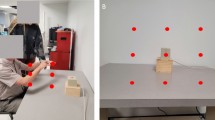Abstract
This study examines whether the kinematics of pointing movements are altered by the sensory systems used to select spatial targets and to guide movement. Hand and joint paths of visually guided reaching movements of human subjects were compared with two non-visual conditions where only proprioception was available: (1) movements of the same subjects with blindfolds, and (2) movements by congenitally blind subjects. While hand-path curvatures were overall quite small, sighted subjects wearing a blindfold showed a statistical increase in hand-path curvature compared with their visually guided movements. Blindfolded subjects also showed greater hand-path curvature than blind subjects. These increases in hand-path curvature for blindfolded subjects did not always lead to a decrease in joint-path curvature. While there were differences between blind subjects and sighted subjects using vision for some movement directions, there was no systematic difference between these two groups. The magnitude of joint-path curvature showed much greater variation than hand-path curvature across the movement directions. We found variation in joint-path curvature to be correlated to two factors, one spatial and one geometrical. For all subject groups, joint-path curvature tended to be smaller for sagittal-plane movements than for transverse or diagonal movements. As well, we found that the magnitude of joint-path curvature was also related to the relative motion at each joint. Joint-path curvature tended to increase when movements predominantly involved changes in shoulder angle and was minimal when movements predominantly involved elbow motion. The consistently small curvatures of hand trajectory across blind and sighted subjects emphasize the powerful tendency of the motor system to generate goal-directed reaching movements with relatively straight hand trajectories, even when deprived of visual feedback from very early in life.
Similar content being viewed by others
Author information
Authors and Affiliations
Additional information
Received: 16 July 1997 / Accepted: 20 May 1998
Rights and permissions
About this article
Cite this article
Sergio, L., Scott, S. Hand and joint paths during reaching movements with and without vision. Exp Brain Res 122, 157–164 (1998). https://doi.org/10.1007/s002210050503
Issue Date:
DOI: https://doi.org/10.1007/s002210050503




